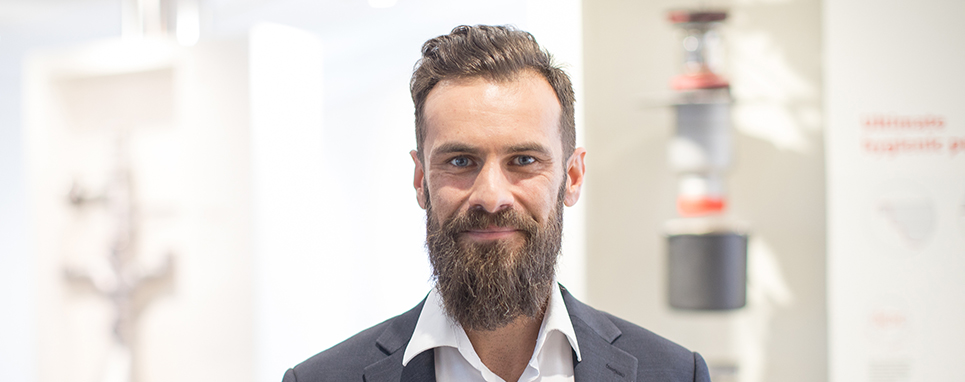

R&D, Drainage specification & The future of drainage
In our latest interview we talk with Daniel Paulus, Head of Product Portfolio Management at ACO Industries, who explains why ACO is so committed to R&D, and why taking an evidence-led approach to product development and specification is so important for the business and its customers.
1. Daniel, why is R&D so important?
At ACO, evidence-led product development is a core part of our overall business strategy. It is important to us that our product designs and the advice we give to our clients is based on the findings of robust academic research that not only enables us to improve the drainage systems we provide but also gives our clients the additional knowledge they need to optimise health and safety, and operational costs. Our focus on R&D and our commitment to ongoing research also helps reassure specifiers and end-users who can be confident that our product performance claims are based on hard facts and not general assumptions.
2. So what types of research does ACO undertake?
Our R&D programme comprises two types of research: Projects commissioned by ACO with independent academic experts and projects undertaken by ACO in partnership with other industry specialists. For example, in the last couple of years we have commissioned an independent research project with the world-renowned Fraunhofer Institute and have also teamed up with flooring specialists, SIKA.
3. Can you provide us with more information about these projects?
The first project was commissioned with Fraunhofer IVV Dresden to establish the impact of hygienic design on drainage performance. Specifically, we wanted to know how the application of hygienic design impacted upon the cleanability of drainage channels and as a consequence, factory hygiene and cleaning costs.
The research compared the performance of the ACO HygieneFirst with another channel whose design is typical of that currently used in food and drinks manufacturing environments. It found that during tests hygienically engineered and designed drainage channels can be effectively and completely cleaned in less than 10 minutes whereas non-hygienic channel still has 2 per cent residual soiling after an extended rinsing time of up to three hours. This gives clear and unambiguous evidence to specifiers and end users about the impact of specifying hygienically designed channel with regard to reducing the risk of bacterial contamination and minimising cleaning costs.
The second R&D project was carried out by our in-house R&D team and a team from leading flooring specialists, SIKA over a period of three years. It was created to help develop best practice guidance for the drainage industry and its clients with regard to the specification of floor-drainage connections. We realised that there was no research into how different flooring types and drainage systems affected each other’s performance and how failures can occurs in the connection between the two. This research has enabled ACO and SIKA to provide clear, scientific, evidence-based specification guidance to specifiers and end users, and is particularly important when drainage is required for a hygiene-sensitive application.
Both of these two projects underline the importance we place on R&D and hopefully illustrate why an evidence-led approach to drainage specification should be a priority for any organisation.
4. What else does ACO do to ensure its product development programme is evidence-led?
It is also important to us that the products and systems we develop for our customers incorporate the best practice design principles of independent bodies such as the European Hygienic Engineering and Design Group (EHEDG). EHEDG comprises a group of research institutes, academic bodies, equipment manufacturers and end users. A not-for-profit organisation, its remit is to improve hygienic engineering and design standards in food, drink and pharmaceutical manufacturing, and it provides a wealth of best practice guidance. Our hygenic drainage range fully incorporates all of EHEDG’s guidelines with regard to drainage design.
5. How does your commitment to R&D impact upon ACO Industries?
It impacts on our business in two key ways: Most importantly it helps us to continually improve the products, systems and advice we provide, to the benefit of our customers and the wider drainage industry. ACO is committed to driving future improvements in drainage performance and our R&D programme enables us to do this. Secondly, research findings are used to inform future investments in new plant and technologies at ACO Industries manufacturing facilities both here at our Pribyslav manufacturing headquarters and also at the other centres of manufacturing excellence we operate across the world.
6. So what’s next?
We will be commissioning further research with Fraunhofer IVV Dresden which to help us to improve the hygienic performance of our products and drainage in general. What’s really important to ACO is to establish how product performance can be enhanced in real life environments. It’s not enough to know how a drainage product or system performs in a laboratory – it has to work when it’s installed in a working factory. We will also be continuing our collaborative work with universities. Key areas of focus will include dynamic loading and the retention capabilities required by the food and drink industry.